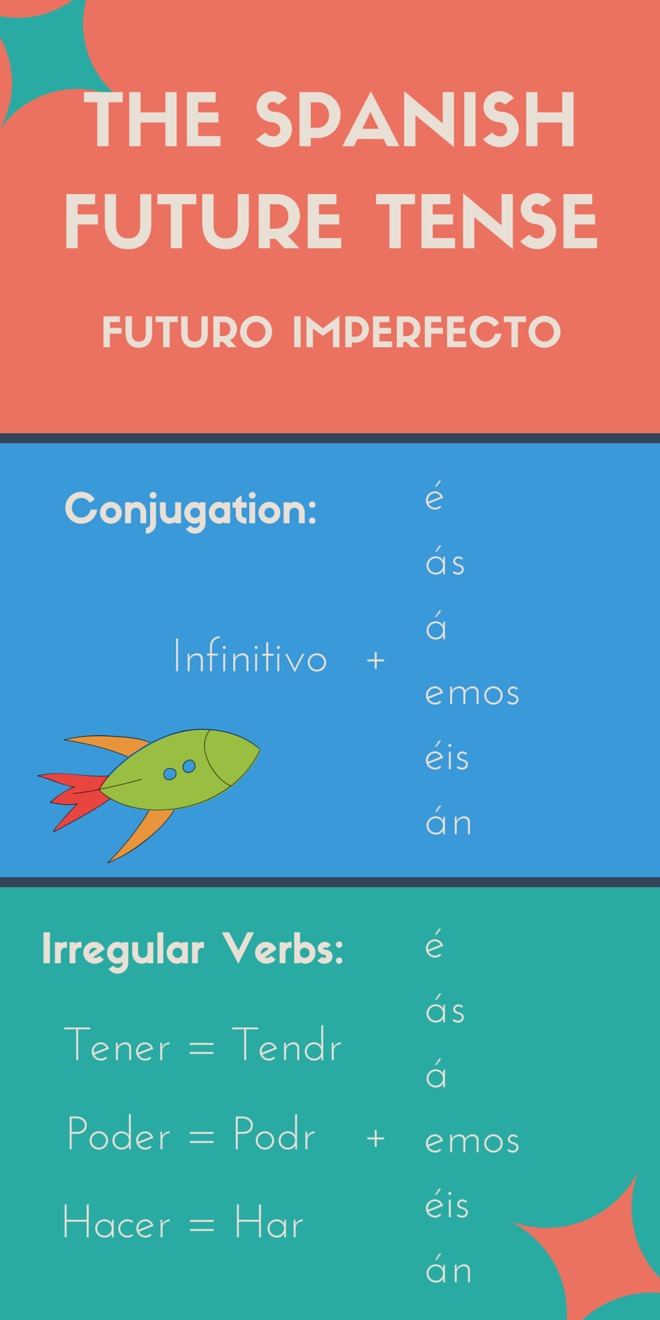The Spanish future tense, also known as el futuro imperfecto, is more versatile than you may think.
Initially, the assumption might be that the future tense is only used for describing future actions.
But, there is a lot more to the story.
The Spanish future tense can be used to make predictions, form hypotheses in the present, discuss unclear plans and make conditional statements.
Despite generally being an easy tense to form, there are a few common errors that English natives often make when using this tense.
In this post you’ll learn how to form the Spanish future tense, you’ll get a list of irregular verbs, and you’ll learn the five common uses of the future tense.
How to form the Spanish future tense
Forming the Spanish future tense can be a lot easier than forming common Spanish verb tenses. This is because you only really need to know the infinitive form of the verb you want to use and one of the six future tense endings.
These six endings are detailed in the following infographic:
 A useful mnemonic that may help with memorising these endings is to think of the following pattern:
A useful mnemonic that may help with memorising these endings is to think of the following pattern:
- e…a…a…e…e…a
Here you can see a few examples of the regular future tense conjugations in action:
| English | Español |
|---|---|
| I will run | Yo correré |
| He will go | Él irá |
| They will need | Ellos necesitarán |
| They will work | Ellos trabajarán |
| She will like | A ella le gustará |
We’ll look at the list of irregular verbs for the future tense soon, but first let’s take a quick look at a common error with pronunciation.
Common error: How to add emphasis for the right pronunciation
A common error that often occurs with the future tense in Spanish is putting the emphasis in the wrong place.
But, this isn’t the only common error. Another common error is pronouncing the future conjugation without enough syllables.
I have difficulty with the Spanish future tense because it often feels like there is one too many syllables than there should be.
To pronounce the future tense properly:
- Pronounce the whole infinitive verb. Then,
- Add emphasis at the end with the appropriate future tense ending.
Let’s look at an example. Take the Spanish verb for ‘to find’:
Encontrar.
In the infinitive form you say ‘en-con-trar‘.
For the future first person form you add é, transforming a three syllable word into a four syllable word:
English: I will find.
Español: Yo encontraré.
So, to say it properly, you need four syllables and the emphasis goes on last syllable, the ‘-ré’. So…
En-con-tra-RE.
Whenever you are practicing pronunciation, remember to: slow down to speed up.
Or, in other words, start slow, slower than is comfortable, then gradually speed up.
I can’t overstate how important this tip is!
So, start off slow, repeat a few times, then build up your pace.
Irregular verbs in the future tense
There are only 12 irregular Spanish verbs in the future tense.
These irregular verbs also apply to the Spanish conditional tense, which is formed in almost exactly the same way.
The 12 irregular verbs for the two tenses and the associated prefixes are:
| Verbo | Prefijo |
|---|---|
| Caber | Cabr |
| Decir | Dir |
| Haber | Habr |
| Hacer | Har |
| Poder | Podr |
| Poner | Pondr |
| Querer | Querr |
| Saber | Sabr |
| Salir | Saldr |
| Tener | Tendr |
| Valer | Valdr |
| Venir | Vendr |
To memorise these verbs, try writing them out on a piece of paper, covering the paper and going again. Then try again tomorrow. Then the day after and then again one week later. That pattern should be enough to help them stick forever.
Once you have these 12 verbs memorised, and the 6 endings from the section above, you will officially have the whole tense ready in mind whenever you need it.
All you need to know now is where you should use it.
Use #1 – To speculate or make predictions about the future
You can use el futuro imperfecto to talk about things that may happen in the future. This could include predictions for the weather, or the result of a sporting match, or what you may do later in a day.
English: I think it will rain tomorrow.
Español: Creo que lloverá mañana.
English: We don’t know where we will eat.
Español: No sabemos donde comeremos.
Use #2 – To make a promise
If you are going to make a promise to someone, make sure you do it using the future tense (promise me you will!!).
English: I promise that I’ll go to the movies with you this weekend.
Español: Te prometo que iré al cine contigo este fin de semana.
English: I swear to you that I will arrive on time.
Español: Te juro que llegaré a tiempo.
Use #3 – To talk about future plans (without knowing precise details)
If you have the intention to do something in the future but don’t yet have the exact plans mapped out, you should use el futuro imperfecto.
English: I’m going to start to learn Spanish one of these days.
Español: Empezaré a aprender español uno de estos días.
English: We will travel to Spain next year.
Español: Viajaremos a España el año que viene.
Use #4 – To form a hypothesis in the present
You can use the Spanish future tense to make a guess about something in the present. For example, someone may ask you for the time and if you don’t have a watch, you’ll have to guess. To do this, you’ll need the future tense.
So if someone asks ¿qué hora es? (what is the time?), and you don’t know exactly, but you think it is about 5 o’clock, you can say:
English: It’ll be 5 o’clock.
Español: Serán las cinco.
Or, someone could ask you if you know where your friend Lorena is. You can say:
English: Lorena will be in the centre of town.
Español: Lorena estará en el centro.
Use #5 – To describe future actions that are based on a condition
When you want to discuss plans or actions that will be based on a condition, you need to use the future tense.
For example:
English: If the weather is nice today, we will go to the park.
Español: Si hace buen tiempo hoy, iremos al parque.
English: If you finish your work early, we’ll eat churros.
Español: Si terminas tu trabajo temprano, comeremos churros.
There is, however, a common error that happens with conditional sentences. Let’s look at that next.
Common error: Use of the conditional tense instead of the future tense
A common mistake for English natives happens when forming conditional sentences. Sentences such as those in ‘Use #5’ above.
Sentences like:
If … then …
The common error is to use the conditional tense when you should be using the future tense.
So, you can say:
If (present tense) then (present tense).
Or:
If (present tense) then (future tense).
But you shouldn’t say:
If (present tense) then (conditional tense) ⊗
For example, here is a conditional sentence with the present tense:
English: If you want to go to the beach, I’ll accompany you.
Español: Si quieres ir a la playa, te acompaño.
You can’t say:
English: If you want to go to the beach, I would accompany you.
Español: Si quieres ir a la playa, te acompañaría. ⊗
Another example, a conditional sentence with the future tense:
English: If you don’t practice often, you will not improve.
Español: Si no practicas a menudo, no mejorarás.
The most annoying aspect if this common error is that the conditional tense doesn’t get used in present conditional constructions. There is a Spanish grammar conditional construction that uses the conditional tense but you need to also use the subjunctive tense (which should be avoided unless you know a heap of vocabulary and the indicative tenses really well).
If you want to see how and where the conditional tense is used, check out this post on the common uses of the conditional tense.
Your turn
How good will your Spanish be as a result of reading this post?
It comes down to how much you practice using the tips and techniques in this post in the near and distant future.
Take a few of the example uses, combine them with a few of the irregular conjugated verbs in the future tense and then use them in combination with your best pronunciation when you next get a change to chat with a Spanish native.
How else can you use the Spanish future tense?




How else can you use the Spanish future tense?
You know Andrew, querer is also a drop the e…. And I like to think of decir and hacer as drop the c and e even though they are not located in the same order in each word….they are the only two verbs on the list with c in the body of the word. Just a thought.
Thanks for all your great teaching! You have a gift!
Thanks for sharing Melissa 🙂
Thanks so much for all this great info.
I want to make sure I’m clear when to use the Present v. Future tense in a conditional situation:
Si quieres ir a la playa, te acompaño.
Is the present used here because the statement is about what they are going to do right now? If you want to go to the beach (now), I’ll acompany you?
Would we then use the future with a conditional situation at a future time?
Si quieres ir a la playa el sábado, te acompañaré?
Thanks for the question Anne, yes, your sentences look great! 🙂 All I will say is that the rules here in this example are not so rigid. For example, the first doesn’t have to use the present tense and the second doesn’t have to use the future tense. But, again, they are both totally fine!
I am having a hard time differentiating uses #2 (to make a promise) and #3 (to sort of, but not really, commit). Given human proclivity to overstate and overcommit, aren’t these really the same thing?
Hola Peg, if you feel that they are same, then no problem!! The categories aren’t that important because we aren’t going to think about them when we are speaking. The key is to notice when we can use the future tense and then practice it!
A very interesting post!
Creo que lloverá mañana.
Is it possible to swap the subjunctive “llueva” for “lloverá” and retain the intent?
Creo que llueva mañana.
Hola Garry, as a general, we shouldn’t follow “creo que” with the subjunctive. We can follow the negative “no creo que” with the subjunctive but not the positive “creo que”. So, it’s best to stick with the future in your example.
As follow up to Use #1, would I be correct in saying that one would use the subjunctive and not the future for:
I don’t believe it will rain tomorrow (No creo que llueva mañana) and
I doubt that it will rain tomorrow (Dudo que llueva mañana)?
Thanks for all you do!
Hola Stephen, yes, that’s correct! 🙂